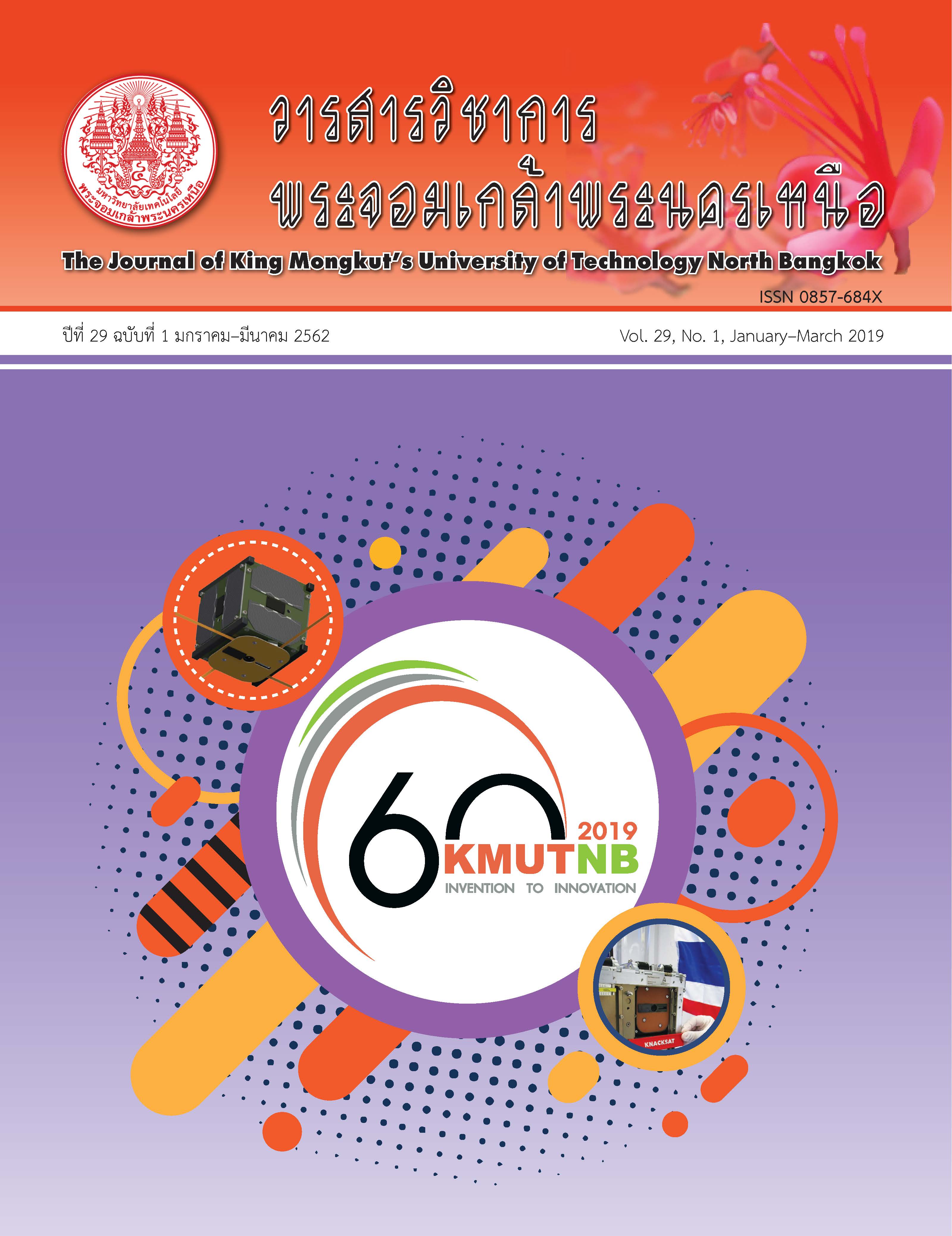เทคนิคการเติมสารทำความเย็นด้วยวิธีการอัดไอสำหรับท่อความร้อน
Main Article Content
บทคัดย่อ
การศึกษาเชิงทดลองในครั้งนี้ เป็นการทดลองการเติมสารทำงานสำหรับท่อความร้อนด้วยไออิ่มตัวของสารทำความเย็นเพื่อหาจุดเหมาะสมของตัวแปรปริมาตรไออิ่มตัวและอุณหภูมิการหล่อเย็นที่เหมาะสม โดยท่อทดสอบทำด้วยทองแดงมีความจุเท่ากับ 40 มล. ทำการทดสอบกับสารทำความเย็น 4 ชนิด ได้แก่ R22, R-134a, R32 และ R404A โดยใช้ปริมาตรของไออิ่มตัวในการทดสอบเท่ากับ 50, 100, 150, 200 และ 300 มล. และอุณหภูมิน้ำหล่อเย็นเพื่อการควบแน่นเท่ากับ 0, 5, 10, 15, 20 และ 25°ซ ใช้หลักการในการอัดไออิ่มตัวด้วยเครื่องอัดไฮดรอลิกเพื่อให้ไออิ่มตัวของสารทำความเย็นเกิดการควบแน่นภายในท่อ ผลการทดลองพบว่าการเติมสารทำความเย็นด้วยวิธีการอัดไอสามารถใช้เติมสารทำความเย็นเป็นสารทำงานให้กับท่อความร้อนโดยลดการสูญเสียของสารทำความเย็นได้เป็นอย่างดี ซึ่งมีความไม่แน่นอนเชิงมวลเฉลี่ยเพียง 3% เมื่ออุณหภูมิหล่อเย็นอยู่ในช่วงระหว่าง 0 ถึง 5°ซ
Article Details
บทความที่ลงตีพิมพ์เป็นข้อคิดเห็นของผู้เขียนเท่านั้น
ผู้เขียนจะต้องเป็นผู้รับผิดชอบต่อผลทางกฎหมายใดๆ ที่อาจเกิดขึ้นจากบทความนั้น
เอกสารอ้างอิง
[2] R. T. Dobson and S A Pakkies, “Development of an air-to-air R-134a refrigerant charged twophase closed thermosyphon heat exchanger,” presented at the 11th International Air Conditioning, Refrigeration & Ventilation Congress, Midrand, South Africa, 2002.
[3] H. Hagens, F. L. A. Ganzevles, C. W. M. van der Geld, and M.H.M. Grooten, “Air heat exchangers with long heat pipes Experiments and predictions,” Applied Thermal Engineering, vol. 27, pp. 2426–2434, 2007.
[4] M. H. M. Grooten and C. W. M. van der Geld, “Predicting heat transfer in long R-134a filled thermosyphons,” Journal of Heat Transfer, vol. 131, no.5, 2009.
[5] B. Jiao, L. M. Qiu, X. B. Zhang, and Y. Zhang, “Investigation on the effect of filling ratio on the steady-state heat transfer performance of a vertical two-phase closed thermosyphon,” Applied Thermal Engineering, vol. 28, no. 11–12, pp. 1417–1426, 2008.
[6] Z. Q. Long and P. Zhang, “Impact of cooling condition and filling ratio on heat transfer limit of cryogenic thermosyphon,” Cryogenics, vol. 52, no. 1, pp. 66–76, 2012.
[7] S. Lips, F. Lefevre, and J. Bonjour, “Combined effects of the filling ratio and the vapour space thickness on the performance of a flat plate heat pipe,” International Journal of Heat and Mass Transfer, vol. 53, no. 4, pp. 694–702, 2010.
[8] H. Jouhara and A. J. Robinson, “Experimental investigation of small diameter two-phase closed thermosyphons charged with water, FC-84, FC-77 and FC-3283,” Applied Thermal Engineering, vol. 30, no. 2–3, pp. 201–211, 2010.
[9] T. Payakaruk, P. Terdtoon, and S. Ritthidech, “Correlations to predict heat transfer characteristics of an inclined closed twophase thermosyphon at normal operating conditions,” Applied Thermal Engineering, vol. 20, no. 9, pp. 781–790, 2000.
[10] Y. H. Yau and Y. C. Foo, “Comparative study on evaporator heat transfer characteristics of revolving heat pipes filled with R134a, R22 and R410A,” International Communications in Heat and Mass Transfer, vol. 38, no. 38, pp. 202–211, 2011.
[11] S. Rittidech, Heat Pipe Technology. Bangkok: Maha Sarakham University Publishing Center, 2011 (in Thai).
[12] G. P. Peterson, An Introduction to Heat Pipes: Modelling Testing and Applications. New York, John Wiley & Sons Inc., 1994.
[13] ASHRAE, I-P ed., American Society of Heating, Refrigerating and Air-Conditioning Engineers, Inc., Atlanta, GA, 2005, pp. 20.1–20.75.

